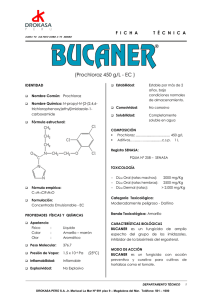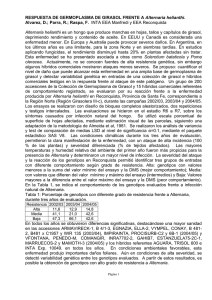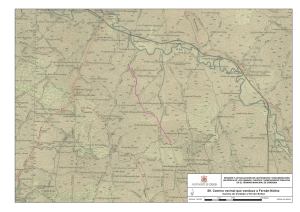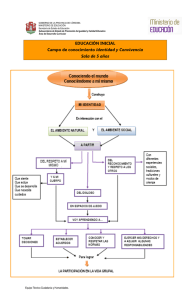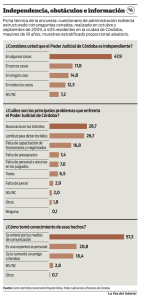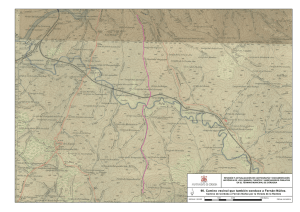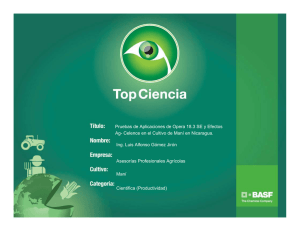a comparative study of the incidence of alternaria conidia in the
Anuncio
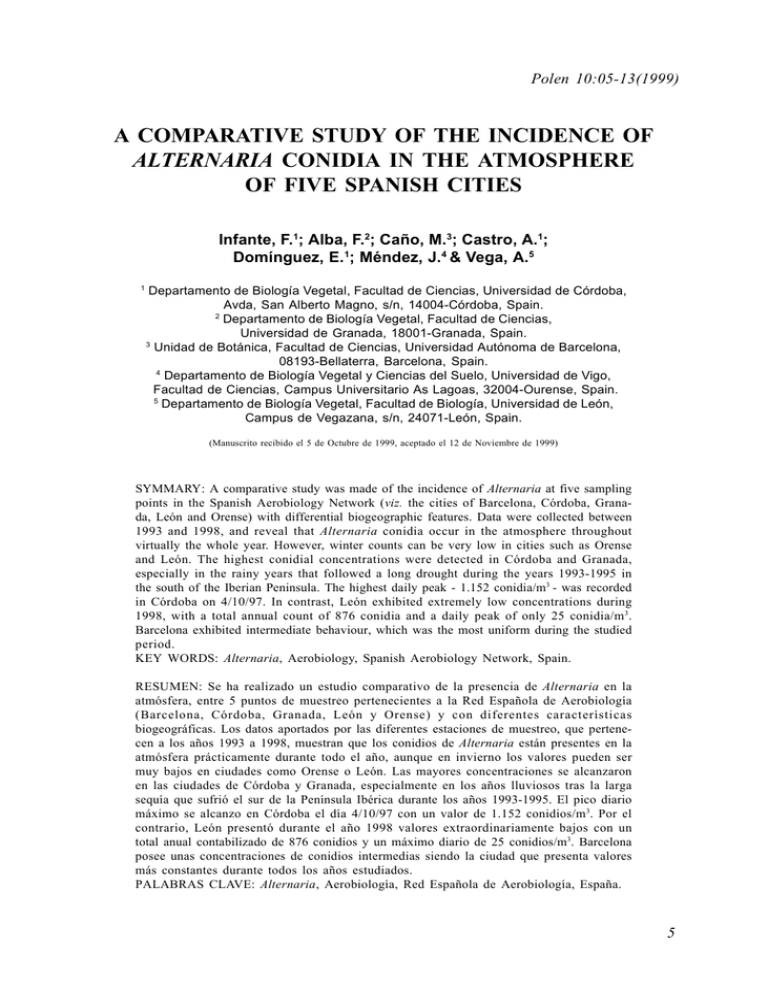
Polen 10:05-13(1999) A COMPARATIVE STUDY OF THE INCIDENCE OF ALTERNARIA CONIDIA IN THE ATMOSPHERE OF FIVE SPANISH CITIES Infante, F.1; Alba, F.2; Caño, M.3; Castro, A.1; Domínguez, E.1; Méndez, J.4 & Vega, A.5 1 Departamento de Biología Vegetal, Facultad de Ciencias, Universidad de Córdoba, Avda, San Alberto Magno, s/n, 14004-Córdoba, Spain. 2 Departamento de Biología Vegetal, Facultad de Ciencias, Universidad de Granada, 18001-Granada, Spain. 3 Unidad de Botánica, Facultad de Ciencias, Universidad Autónoma de Barcelona, 08193-Bellaterra, Barcelona, Spain. 4 Departamento de Biología Vegetal y Ciencias del Suelo, Universidad de Vigo, Facultad de Ciencias, Campus Universitario As Lagoas, 32004-Ourense, Spain. 5 Departamento de Biología Vegetal, Facultad de Biología, Universidad de León, Campus de Vegazana, s/n, 24071-León, Spain. (Manuscrito recibido el 5 de Octubre de 1999, aceptado el 12 de Noviembre de 1999) SYMMARY: A comparative study was made of the incidence of Alternaria at five sampling points in the Spanish Aerobiology Network (viz. the cities of Barcelona, Córdoba, Granada, León and Orense) with differential biogeographic features. Data were collected between 1993 and 1998, and reveal that Alternaria conidia occur in the atmosphere throughout virtually the whole year. However, winter counts can be very low in cities such as Orense and León. The highest conidial concentrations were detected in Córdoba and Granada, especially in the rainy years that followed a long drought during the years 1993-1995 in the south of the Iberian Peninsula. The highest daily peak - 1.152 conidia/m3 - was recorded in Córdoba on 4/10/97. In contrast, León exhibited extremely low concentrations during 1998, with a total annual count of 876 conidia and a daily peak of only 25 conidia/m3. Barcelona exhibited intermediate behaviour, which was the most uniform during the studied period. KEY WORDS: Alternaria, Aerobiology, Spanish Aerobiology Network, Spain. RESUMEN: Se ha realizado un estudio comparativo de la presencia de Alternaria en la atmósfera, entre 5 puntos de muestreo pertenecientes a la Red Española de Aerobiología (Barcelona, Córdoba, Granada, León y Orense) y con diferentes características biogeográficas. Los datos aportados por las diferentes estaciones de muestreo, que pertenecen a los años 1993 a 1998, muestran que los conidios de Alternaria están presentes en la atmósfera prácticamente durante todo el año, aunque en invierno los valores pueden ser muy bajos en ciudades como Orense o León. Las mayores concentraciones se alcanzaron en las ciudades de Córdoba y Granada, especialmente en los años lluviosos tras la larga sequía que sufrió el sur de la Península Ibérica durante los años 1993-1995. El pico diario máximo se alcanzo en Córdoba el día 4/10/97 con un valor de 1.152 conidios/m3. Por el contrario, León presentó durante el año 1998 valores extraordinariamente bajos con un total anual contabilizado de 876 conidios y un máximo diario de 25 conidios/m3. Barcelona posee unas concentraciones de conidios intermedias siendo la ciudad que presenta valores más constantes durante todos los años estudiados. PALABRAS CLAVE: Alternaria, Aerobiología, Red Española de Aerobiología, España. 5 Infante et al. INTRODUCTION The atmospheric incidence of Alternaria has been the subject of numerous studies on the phytopathogenic and/or saprophytic action of this fungal genus on plants. Due to its high colonizing capacity and its ability to degrade sugars, pectins and lignin, it is commonly found on plants, paper, leather, upholstery and foods. It is therefore a typically cosmopolitan genus. In addition to being a plant pathogen, the significance of Alternaria lies in its ability to trigger respiratory diseases and allergic processes that are occasionally accompanied by bronchial asthma. All of this is favored by its virtual perennial presence in the atmosphere, inside buildings and in home dust (INFANTE et al., 1992; ANGULO et al., 1996) where it fosters growth of other major allergens: dust mites (INFANTE, 1997). Seemingly, Alternaria acts synergically with other fungi and Poaceae pollen, with which it shares antigens on its cell walls; most authors consider this genus and Cladosporium to be the most important fungal aeroallergens (RESANO et al., 1998). The high interest in Alternaria has promoted a vast number of aerobiological studies that have examined the incidence, variation and species of Alternaria present in the air. A number of these studies have been conducted in Spain. Thus, aerobiological experiments involving traps containing a culture medium have enabled the isolation of various Alternaria species, namely: A. brassicicola, A. consortiale, A. crassa, A. chartarum, A. dendritica, A. japonica, A. oleracea, A. alternata and A. tenuissima (HERRERO et al., 1996a; INFANTE et al., 1987a, b; MEDIAVILLA et al., 1992, 1996; INFANTE et al., 1992). 6 However, overall counts for this genus are more widely available since the use of Hirst traps enables their easy detection; pigmented dictyoconidia have a typical shape and a large size (30-50 x 10-14 µm), and can be found in chained or isolated form. The atmospheric incidence of Alternaria has been the subject of research in recent years at Spanish locations such as Badajoz (GONZALO et al., 1996), Barcelona (BELMONTE et al., 1992), Cádiz (GONZÁLEZ-MINERO et al., 1994; CANDAU et al., 1995), Córdoba (DOMÍNGUEZ et al., 1995; GALÁN et al., 1998a, b; ANGULO et al., 1999), Huelva (CANDAU et al., 1995; GONZALEZ-MINERO et al., 1993, 1994, 1995; GONZÁLEZ-MINERO & CANDAU, 1996), La Laguna (DOMÍNGUEZ & LA SERNA, 1996), León (FERNÁNDEZ-GONZÁLEZ et al., 1993; FERNÁNDEZ et al., 1998), Murcia (MUNUERA & CARRIÓN, 1995; MUNUERA et al., 1998), Orense (MÉNDEZ et al., 1997), Palencia (HERRERO et al., 1996a, b) and Seville (CANDAU et al., 1995). Although there is a great deal of literature on the incidence of Alternaria in the air of some Spanish cities, there is a lack of comparative studies on the aeromycoflora of our country. This is the main objective of a joint project currently being carried out by several members of the Spanish Aerobiology Network (Red Española de Aerobiología, called REA). The work reported in this paper is part of its results and aims to reveal potential similarities and differences in the incidence of Alternaria conidia in the atmosphere of peninsular Spain. MATERIAL AND METHODS Atmospheric conidial counts were taken for five Spanish cities (Barcelona, Córdoba, Polen Aerobiology of Alternaria in Spain Granada, León and Orense) belonging to the REA. Atmospheric conidia were captured using a Hirst-type volumetric inert medium trap (Burkard or Lanzoni) in order to obtain daily samplings; the trap was adjusted to aspirate 10 liters of air per minute. Conidia were counted under a light microscope (400x) using two lengthwise counts except at the Barcelona site, where only one count was performed per daily preparation. Counts were multiplied by appropriate factors for extrapolation to the whole preparation and expressed as conidia/m3 of air for consistency with the methodology used by the REA (DOMÍNGUEZ et al., 1992). This methodology provides counts with very small error due to the high fungal concentrations present in the Spanish atmosphere. droughts and two wet seasons (spring and autumn). The vegetation around the trap includes typically urban ornamental plants and ruderals, as well as residual riverside trees such as elms (Ulmus) willows (Salix), poplars (Populus) and horticultural and fruit crops, together with vestiges of natural vegetation such as reeds and glassworts (Salicornia sp.). In the north is Sierra de Collserola, largely covered with littoral holmoak (Quercus ilex subsp. ilex) woods heavily eroded by human action; it also exhibits degradation series, frequently covered with pines (Pinus halepensis and P. pinea), and dry meadows (BELMONTE et al., 1998). The data used in the study were obtained over the 1995–1998 period. Since the sampling sites studied were geographically disperse, they exhibited differences in certain parameters such as height, climate, vegetation, etc., and these are summarized in Table 1 and discussed below. CÓRDOBA SAMPLING SITE (S–SW OF THE IBERIAN PENINSULA) BARCELONA SAMPLING SITE (NE OF THE IBERIAN PENINSULA) The trap was located in the NW of the city, about 2 km from Sierra de Collserola and 3 km from the sea. Barcelona has a subhumid, maritime, temperate climate tending to maritime (BOLÓS, 1962) and a typically Mediterranean rain regime, with long summer The trap was located at the building of the Faculty of Sciences, on the outskirts of the city, W–SW of the urban area and with no shielding buildings around. The city of Córdoba is located in the river Guadalquivir valley, and is flanked by Sierra Morena in the NE. It has a Mediterranean climate, with some continental and dry ombroclimatic features, which were particularly apparent in the studied period, which included extremely dry years. The trap is under the direct influence of Sierra Morena, which is covered with thermo-Mediterranean vegetation consisting of holm-oaks (Quercus ilex Sites Sampling station Station height (m a.s.l.) Trap height (m a.g.) Mean temperature (ºC) Annual rainfall (mm) Barcelona (41º 24’ N, 2º 09’ E) 90 25 16.5 595 Córdoba (37º 50’ N, 4º 45’ W) 123 15 18 600 Granada (37º 11’ N, 3º 35’ W) 685 18 15 400 León (42º 34’ N, 5º 35’ W) 860 15 10 550 Orense (42º 21’ N, 7º 51’ W) 130 20 14 818 TABLE 1. Location and essential climatic features of the sampling sites. Vol. 10 (1999) 7 Infante et al. subsp. rotundifolia) and, to a lesser extent, cork oaks (Q. suber); once the climax ceases, the bush stage consists of kermes oak (Q. coccifera), lentiscus (Pistacia lentiscus) and rockroses (Cistus). Extensive areas have been repopulated with Pinus, forming a mixed wood. The Guadalquivir valley, together with the other areas with a major influence on the trap, have various horticultural, fruit and intensive crops, as well as ruderal plants and riverside woods. The data from this sampling station were collected from 1993 through 1997. GRANADA SAMPLING SITE (S–SE OF THE IBERIAN PENINSULA) The city of Granada lies in the so-called Intra-Baetic Furrow and is strongly influenced by its proximity to the mountain region of Sierra Nevada. This results in a continental Mediterranean climate with strongly contrasting inter-seasonal temperatures and rainfall (CAPEL-MOLINA, 1981). The vegetation series consists largely of basophilic Baetic meso-Mediterranean holmoak woods which have been replaced with pines (Pinus sp.) in many places (DÍAZ DE LA GUARDIA & ALBA, 1998). Also worth noting is the extensive presence of crops, as well as ornamental flora in the urban area. Data from this site were collected in 1994 and 1998. LEÓN SAMPLING SITE (NW IBERIAN PENINSULA) The trap was located in the urban area of the city, which lies in the NW of the Spanish plateau, about 20 km from a mountainous region, which strongly influences its climatic features. In fact, it possesses a mesothermal Mediterranean, temperate, humid climate with dry summers and rainy winters, in addition to contrasting winter and summer temperatures (ROLDÁN, 8 1987). The vegetation of the area consists mainly of Mediterranean riparious geomegaseries and irrigated crops (elms, poplars and willow trees and bushes, as well as Pyrenean oaks (Quercus pyrenaica), holm-oaks and replacement stages including abundant moors). Another significant feature is the presence of croplands and ornamental urban flora (FERNÁNDEZGONZÁLEZ et al., 1998). Data from this site were collected in 1994, 1995 and 1998. ORENSE SAMPLING SITE (NW OF THE IBERIAN PENINSULA) The city of Orense lies in the depression where the rivers Miño, Loña and Barbaña converge. The area is in a subhumid Mediterranean-to-Atlantic region, on the edge of the subhumid Mediterranean-to-Central European subregion. As a result, rainfall is not uniformly distributed throughout the year and the summer is drier than the other seasons (ALLUÉ, 1966). The potential vegetation in the area influencing the trap includes Pyrenean oaks and other species such as oak (Q. robur), cork oaks or chestnut (Castanea sativa). Also, in the vicinity of the trap is a coppice of Frangula alnus, laurel (Laurus nobilis) and Genista falcata, highly degraded by the introduction of pines and eucalyptus (Eucalyptus sp.) (IGLESIAS et al., 1998). Data from this site were collected over the 1993–1996 period. RESULTS AND DISCUSSION Table 2 lists selected results obtained from the above five mentioned cities. Results for each year studied at each sampling point include the total conidial count, and the peak count and its date. Based on these results, Granada and Córdoba yielded the highest atmospheric counts of Alternaria. In fact, Polen Aerobiology of Alternaria in Spain the highest concentrations of the study were recorded in Córdoba in 1997, which on 4 October that year gave the highest daily count of all (viz. 1.152 conidia/m3, which was much higher than all other values recorded during the study). In contrast, León in 1998 yielded the lowest Alternaria counts of the study (viz. an total annual count of 876 conidia and a peak of only 25 conidia/m3 on 4 June). Both values are very small in comparison to those obtained at the other sampling points. Also worth noting is the fact that the Barcelona site exhibited the most uniform total annual counts of the five cities studied. Particularly significant was the dramatic increase in the number of conidia detected in Córdoba during 1996 and 1997, and in Granada in 1998, in comparison with previous years. The increase, pending statistical correlation with meteorological parameters, was almost obviously a result of the heavy rainfall in those years, which ended a long drought in the south of the Iberian Peninsula. Table 2 also shows the annual mean of the daily counts obtained at each sampling station, as well as the number of days when the mean was surpassed each year. These data enabled a comparison of the five sampling sites and their classification into three groups: (1) Granada and Córdoba, with the highest counts (with daily means of 38.04 and 37.53, respectively); (2) Orense and León, with the lowest mean counts (6.02 and 9.55, respectively); and (3) Barcelona, with intermediate values (18.82). However, Barcelona exhibited one special feature: daily counts exceeded the annual daily mean at least 100 days each year studied. This was not the case with the other sampling stations, where at least one of the years studied exhibited very few days with values above the mean (Tab. 2). A comparison of this result with the total annual counts confirms that Barcelona was the sampled city with the most uniform and sustained atmospheric incidence of Alternaria. This may have been due to the fact that it was the only sampling site located near to the coast. The influence Date of the peak Annual mean of conidia (local) Nº of days where mean was exceeded (local) 235 311 157 179 03/11/95 22/06/96 04/01/97 28/08/98 18,82 100 131 135 119 89 118 120 106 7.384 9.760 3.788 14.268 33.331 163 876 117 332 1.152 21/09/93 01/06/94 11/05/95 22/10/96 04/10/97 37,53 52 40 20 112 182 85 56 45 148 215 1994 1998 9.474 18.297 302 361 28/05/94 02/06/98 38,04 68 155 115 245 León 1994 1995 1998 5.047 4.530 876 145 131 25 31/05/94 19/07/95 04/06/98 9,55 131 118 25 78 72 2 Orense 1993 1994 1995 1996 1.052 2.382 3.341 2.023 58 62 101 70 27/06/93 23/06/94 06/07/95 22/10/96 6,02 51 121 139 101 5 28 48 22 Sampling station Year Total annual count (conidia) Barcelona 1995 1996 1997 1998 6.590 7.263 7.232 6.406 Córdoba 1993 1994 1995 1996 1997 Granada Peak value (conidia) Annual mean of conidia (overall) 21,76 Nº of days where mean was exceeded (overall) TABLE 2. Results obtained for each sampling site and year. Vol. 10 (1999) 9 Infante et al. of the sea, with milder climatic conditions and more uniform moisture regimes than those of the other cities, may have exerted an influence on the annual variation pattern obtained (Fig. 1). Finally, Table 2 also shows mean daily counts of Alternaria as calculated from the whole data set. Mean daily Alternaria conidia counts were 21.76; based on the period studied and on the distribution of the sampling stations, this could be taken as a reference value for the whole peninsular Spain. The data in the furthest right column of Table 2, which shows the number of days when this value was exceeded each year, are fairly consistent; thus, in the cities with higher counts, the number of days on which the mean was exceeded were also higher and vice versa. Nevertheless, these data afford a preliminary comparison of the incidence of Alternaria between the sampled cities and years. In order to facilitate the comparison of the sampling sites, a mean curve was plotted using the data available for each (Fig. 1); Córdoba 250 50 200 3 40 Conidia m Conidia m 3 Barcelona 60 30 20 150 100 50 10 0 0 1 2 3 4 5 6 7 8 9 10 1 11 12 2 3 4 5 6 Months 9 10 11 12 50 200 8 9 10 11 12 3 250 40 30 20 150 100 50 10 0 0 1 2 3 4 5 6 7 8 9 10 11 12 1 2 3 4 5 Months 6 7 Months Total annual count León 60 16000 13.724 Total of conidia 50 3 8 Granada 60 Conidia m Conidia m 3 Orense Conidia m 7 Months 40 30 20 10 13.886 12000 8000 6.934 3.499 4000 2.322 0 1 2 3 4 5 6 7 Months 8 9 10 11 12 0 Barcelona Córdoba Granada León Orense FIGURE 1. Mean curve for each sampling site and total conidial counts derived from it. 10 Polen Aerobiology of Alternaria in Spain this can be used as a temporary model until a larger data set is available. Data were also smoothed by using the moving mean for 7 days. Figure 1 also shows the variation of the total annual conidial counts corresponding to the mean curve for each sampling site; the plot highlights the abovementioned differences between sampling sites (in terms of the high concentrations of Granada and Córdoba as compared with the other cities, and the intermediate position of Barcelona). Figure 1 also reveals that Córdoba and Granada exhibit similar behaviour, probably as a result of their geographic proximity and their very similar overall climates. These two sampling sites present a very similar annual variation pattern, with two main seasons in which atmospheric concentrations of Alternaria are higher than during the rest of the year. Concentrations are low in winter, rise significantly in spring, fall during the summer and rise again in autumn, albeit without any of the high peaks recorded in the spring. Variation patterns for the northern cities (Barcelona, León and Orense) are not so markedly seasonal. In fact, they exhibit a single period of increased concentrations; in these three cities, concentrations increase during May and June, peak in the summer and then fall in late autumn, remaining at low levels during the winter. Nevertheless, León presents a significant peak during March, due to the fact that the concentrations reached during that month in the year 1994 exceeded those recorded in the other years. CONCLUSIONS The data obtained in this study enable the following conclusions to be drawn: Vol. 10 (1999) 1. Alternaria occurs in the atmosphere of the five sampled cities (Barcelona, Córdoba, Granada, León and Orense) throughout the year. However, conidial concentrations can be very low in winter. There are substantial differences in total inter-annual conidial counts among years in each city and among cities. 2. Granada and Córdoba exhibit the highest conidial counts. In contrast, Orense exhibits the lowest counts, closely followed by León. Barcelona is in an intermediate position, with a large, uniform number of days each year on which conidial concentrations exceed the annual mean. 3. The southern cities (Córdoba and Granada) exhibit a very similar annual variation pattern, with two well-defined seasons (spring and autumn) in which Alternaria counts are higher than during the rest of the year. This is not the case with the northern cities (Barcelona, León and Orense); although their concentrations are subject to rises and falls, they tend to peak between June and November. Barcelona presents the most uniform and constant incidence of Alternaria of all the cities studied here. ACKNOWLEDGEMENTS This work was funded by Spain’s “Programa Nacional de Investigación y Desarrollo Tecnológico” (National Technical Research and Development Program) through Project AMB-0457. REFERENCES ALLUÉ, A.J.L. (1966). Subregiones fitoclimáticas de España. I.F.I.E. Ministerio de Agricultura, Madrid. 11 Infante et al. ANGULO, J.; MEDIAVILLA, A. & DOMÍNGUEZ, E. (1999). Conidia of Alternaria in the atmosphere of the city of Córdoba, Spain in relation to meteorological parameters. Int. J. Biometeorol. 43:45-49. ANGULO, J.; INFANTE, F.; DOMÍNGUEZ, E.; MEDIAVILLA, A. & CARIDAD-OCERÍN, J.M. (1996). Pathogenic and antigenic fungi in school dust of the south of Spain. In: M. MUILENBERG & H. BURGE (eds). Aerobiology, pp. 49-65. CRC Press Inc., Boca Raton. T.; VEGA, A. & SAGÜÉS, E. (1998). Daily and seasonal variations of Alternaria and Cladosporium airborne spores in León (North-West, Spain). Aerobiol. 14:215-220. FERNÁNDEZ-GONZÁLEZ, M.D.; SUÁREZ-CERVERA, M.; DÍAZ-GONZÁLEZ, T.E. & VALENCIABARRERA, R.M. (1993). Airborne pollen and spores in León (Spain). Int. J. Biometeorol. 37:89-95. BELMONTE, J.; ROURE, J.M.; BOTEY, J. & CADAHIA, A. (1992). Espores a l’atmosfera de Catalunya. Ann. Med. (Barc.) 78(1):11-15. FERNÁNDEZ-GONZÁLEZ, M.D.; VALENCIABARRERA, R.M.; VEGA, A. & SAGÜÉS, E. (1998). Aerobiología en Castilla y León: estación de León (1995-1996). Bol. Red Esp. Aerobiol. 3:49-52. BELMONTE, J.; VENDRELL, M. & ROURE, J.M. (1998). Aerobiología en Cataluña: estación de Barcelona (1995-1996). Bol. Red Esp. Aerobiol. 3:53-56. GALÁN, C.; CARIÑANOS, P.; ALCÁZAR, P.; INFANTE, F.; CASTRO, A. & DOMÍNGUEZ, E. (1998a). Aerobiología en Andalucía: Estación de Córdoba. Bol. Red Esp. Aerobiol. 3:13-16. BOLÓS, O. (1962). El paisaje vegetal barcelonés. Facultad de Filosofía y Letras. Universidad de Barcelona, Barcelona. GALÁN, C.; CARIÑANOS, P.; ALCÁZAR, P.; INFANTE, F.; CASTRO, A. & DOMÍNGUEZ, E. (1998b). Aerobiología en Andalucía: Estación de Córdoba (1997). Bol. Red Esp. Aerobiol. 4:21-24. CANDAU, P.; GONZÁLEZ-MINERO, F. & GONZÁLEZ-ROMANO, M.L. (1995). Aerobiología de Andalucía Occidental: Cádiz, Huelva y Sevilla. Bol. Red Esp. Aerobiol. 1:33-38. CAPEL-MOLINA, J.J. (1981). Los climas de España. Barcelona. DÍAZ DE LA GUARDIA, C. & ALBA, F. (1998). Aerobiología en Andalucía: estación de Granada (1995-1996). Bol. Red Esp. Aerobiol. 3:21-24. GONZÁLEZ-MINERO, F.J. & CANDAU, P. (1996). Alternaria y Cladosporium: aeroalérgenos en la atmósfera de Huelva. Studia Bot. 13:83-86. GONZÁLEZ-MINERO, F.J.; CANDAU, P. & CEPEDA, J.M. (1994). Airborne spores of Alternaria (SW Spain), relationship with meteorological factors. Rev. Iberoam. Micol. 11:92-95. DOMÍNGUEZ, E.; GALÁN, C. & INFANTE, F. (1995). Aerobiología de Andalucía Central: Córdoba. Bol. Red Esp. Aerobiol. 1:39-42. GONZÁLEZ-MINERO, F.J.; CANDAU, P. & GARCÍARODRÍGUEZ, E. (1995). Aeromicoflora de la atmósfera de Huelva y su interés en la alergia respiratoria. Aestuaria 12:160-168. DOMÍNGUEZ, E.; GALÁN, C.; VILLAMANDOS, F. & INFANTE, F. (1992). Handling and evaluation of the data from the aerobiological sampling. Monografias REA/EAN Nº 1. Editado por el Departamento de Biología Vegetal y Ecología, Universidad de Córdoba. GONZÁLEZ-MINERO, F.J.; GONZÁLEZ-ROMANO, M.L.; ROMERO, F.; PINEDA, F. & CANDAU, P. (1993). Airborne fungal spores trend over a highly polluted area of south-west Spain using Cour’s trap. Aerobiol. 9:39-45. DOMÍNGUEZ, M.D. & LA-SERNA, I. (1996). Variación anual y diaria del contenido de esporas de Alternaria, Cladosporium, Fusarium y Stemphylium en la atmósfera de La Laguna (Tenerife: Islas Canarias). Bot. Macaronesica 23:105-117. GONZALO, M.A.; MARTÍNEZ, J.F.; TORMO, R.; MUÑOZ, A.F.; PAREDES, M.M. & SILVA, I. (1996). Estudio aeromicológico de la ciudad de Badajoz: períodos de mayo a agosto de 1993 y 1994. Rev. Esp. Alergol. Immunol. Clin. 11(4):188-194. FERNÁNDEZ, D.; VALENCIA, R.M.; MOLNÁR, 12 Polen Aerobiology of Alternaria in Spain HERRERO, B.; FOMBELLA-BLANCO, M.A.; FERNÁNDEZ-GONZÁLEZ, M.D. & VALENCIABARRERA, R.M. (1996a). Aerobiological study of fungal spores of Palencia (Spain). Aerobiol. 12:27-35. MEDIAVILLA, A.; ANGULO, J.; RODERO, J.M.; DOMÍNGUEZ, E.; GALÁN C. & INFANTE, F. (1996). Fungal contamination of potential medical interest in Spanish grain stores. J. Invest. Allergol. Clin. Immunol. 6(3):196-201. HERRERO, B.; FOMBELLA-BLANCO, M.A.; FERNÁNDEZ-GONZÁLEZ, M.D. & VALENCIABARRERA, R.M. (1996b). The role of meteorological factors in determining the annual variation of Alternaria and Cladosporium spores in the atmosphere of Palencia, 1990-1992. Int. J. Biometeorol. 39:139-142. MEDIAVILLA, A.; INFANTE, F.; ANGULO, J. & DOMÍNGUEZ, E. (1992). Catálogo de los hongos presentes en silos de la provincia de Córdoba (España). Act. Bot. Malacit. 17:57-66. IGLESIAS, I.; MÉNDEZ, J. & SEIJO, C. (1998). Aerobiología en Galicia: estación de Ourense (1995-1996). Bol. Red Esp. Aerobiol. 3:73-76. INFANTE, F. (1997). Caracterización Aerobiológica de los Principales Hongos de Interior. Rev. Portuguesa Imunoalergol. 5(2):108-115. INFANTE, F.; DOMÍNGUEZ, E.; RUIZ DE CLAVIJO, E. & GALÁN, C. (1987a). Incidence of Alternaria Nees ex Fries. in dwelling of Córdoba City (Spain). Allergol. Immunopathol. 15(4):221-224. INFANTE, F.; GALÁN, C.; DOMÍNGUEZ, J. ANGULO, J. & MEDIAVILLA, A. (1992). Air spore microfungi in dwellings of South of Spain. Aerobiol. 8(2):245-253. INFANTE, F.; RUIZ DE CLAVIJO, E.; GALÁN, C. & DOMÍNGUEZ, E. (1987b). Estudio comparativo de Alternaria Nees ex Fries. en el aire de exterior e interior en la ciudad de Córdoba. An. Asoc. Palinol. Leng. Esp. 3:5-11. Vol. 10 (1999) MÉNDEZ, J.; IGLESIAS, M.I.; JATO, M.V. & AIRA, M.J. (1997). Variación estacional de esporas de Alternaria, Cladosporium y Fusarium en la atmósfera de Ourense (año 1993-1994). Polen 8:79-88. MUNUERA, M. & CARRIÓN, J.S. (1995). Daily variations of Alternaria spores in the city of Murcia (semi-arid osutheastern Spain) Relationship with weather variables. Int. J. Biometeorol. 38:176-179. MUNUERA, M.; CARRIÓN, J.S. & GARCÍA, J. (1998). Incidence of Alternaria spores in the atmosphere of Murcia (SE Spain). Seasonal, monthly an intradiurnal variations. J. Invest. Allergol. Clin. Immunol. 8(5):304-308. RESANO, A.; SANZ, M.L. & OEHLING, A. (1998). Sensitization to Alternaria and Cladosporium in asthmatic patients and its in vitro diagnostic confirmation. J. Invest. Allergol. Clin. Immunol. 8(6):353-358. ROLDÁN, A. (1987). Notas para una climatología de León. Instituto Nacional de Meteorología. Madrid. 13

